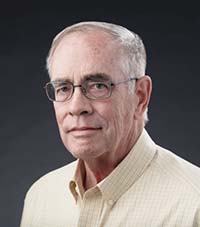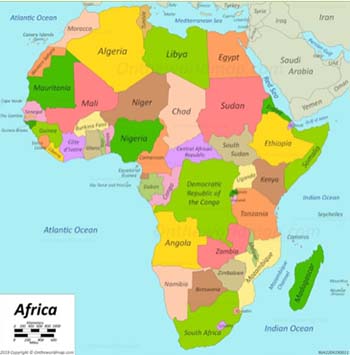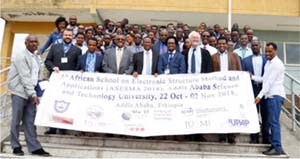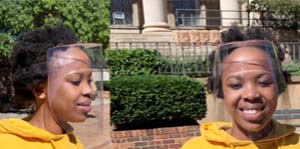Africa, Physics in Africa, and the African Physics Newsletter
Recently, American Physical Society began publishing the African Physics Newsletter, an email publication, composed by African physicists, reporting news of interest to physicists in Africa. In this short note, I will review the need for such a newsletter, highlight some of its articles, and discuss how you can help sustain its publication.
The newsletter emerged out of the desire of the APS’s Committee on International Scientific Affairs to sponsor some projects that would benefit physics in Africa. To help identify possible projects, the Committee first sponsored a survey of the state of physics in Africa. From this survey, it was apparent that physics was a growing activity, but there were communication gaps among the African physicists, and between non-African and African physicists, that often hid what was happening. Some issues simply had to do with the nature of Africa and others had to do with the relatively small sizes and dispersion of the physics communities.

James E. Gubernatis
To take a closer look at some of these issues, let me start by saying that Africa a huge continent. You can fit China, India, the United States, and Europe all together within its coastline. To set the scale, Nigeria in the accompanying map of Africa (on the west about halfway south) is the size of Texas. Africa is also fascinatingly diverse politically, economically, culturally, religiously, and geographically, but often gets overly simplified by grouping the countries into those in North and sub-Saharan Africa. About 30% of Africa is desert, and although the Sahara Desert was once crossed by trade routes between the great empires of Africa, since the 17th century of the common era it has been a natural barrier that has led to Northern and Southern Africa developing quite independently. That was yesterday. Today, there is the World Wide Web are the routes connecting all countries, but for Africa ,the Internet connects only about 13% of Africans, and even then, intermittent access to electricity and prices for data pose barriers. The common Anglophone and Francophone categories are also simplistic. Most countries have multiple official languages: South Africa has eleven.
An unfortunate fact about Africa is that it is a continent of developing countries. In fact, approximately 60% of the world’s developing countries are African. Of the 55 African countries, only the Seychelles Islands, not the African country that usually first comes to mind, is in the high income or “developed” group. Twenty-four of the world’s twenty-nine lowest income countries are African. It is this economics that has kept the size of physics small even in some countries that rank among the world’s most populous.

In high-income countries, physics benefits enormously from the journals, newsletters, and meetings provided by our national physics societies. In Africa, the national physical societies are small (30 to 1000 dues-paying members). At the time of the survey, there were just nine. Those in South Africa and Nigeria are likely the only ones that regularly publish a newsletter and hold annual meetings. Almost all operate on a volunteer basis. Additionally, there are only a few pan-African physics organizations and activities. As a consequence, the natural infrastructures by which physicists typically communicate what is happening in their country through their physical societies or across the continent through their participation and attendance in topical or sub-field conferences and workshops are weak.

The continent is changing. Physics in Africa is a growing activity. Countries are trying to establish more technologically based economies which has led to more agricultural, medical, science, and engineering funding and a greater need for training in physics. Research budgets are increasing, and as a consequence the number of physics research publications is increasing, as is the number of topical and regional physics meetings. There are at least two pan-African physics schools, the African School on Methods of Electronic Structure and Materials Applications (ASESMA) and the African School on Fundamental Physics and its Applications (ASP), that have enjoyed growth over their ten years of operation. An African Materials Research Society now exists, and the Abdus Salam International Center for Theoretical Physics (ICTP) recently opened its first institute in Africa, the East African Institute for Fundamental Physics in Rwanda. There are now fifteen national physical societies, and the Portuguese-speaking countries, in concert with the physical societies of Portugal and Brazil, have formed a physics union. Noteworthy is a team of African and non-African physicists being awarded an APS Innovation Grant. In short, there is a lot of physics happening that merits reporting to the physics communities in Africa and sharing with physics communities outside of Africa.
It is in this milieu that the African Physics Newsletter was started. The newsletter appears quarterly, is in English, and is distributed via email. Its subscription is free and open to all: you do not have to be a physicist or African to subscribe. A volunteer Editorial Board of African physicists gathers and copyedits the news articles. APS formats the articles into a newsletter and distributes the document via email. The sixth issue was published early June.
The principal features of the newsletters are a Save the Date column that lists and links to upcoming conferences and workshops and eight to ten short articles that usually link to larger articles or websites from which more information is available. Some of these articles are in fact announcements of the upcoming events and in some other cases are reports on what occurred at them. Important clients are ASESMA, APS, and their offshoots.
To give examples of the scope of the articles, several have reported recent notable research results. MeerKAT, the world’s largest radio astronomy telescope, is coming on-line in South Africa. It has already come up with new discoveries, such as the discovery of giant radio bubbles at our galactic center and the location of missing hydrogen gas in the southern galaxy NGC1319, that have led to publications in Nature. Several articles have been about other types of recognition people have received for their research. For example, there was an article about a young man from Kenya whose Ph.D. thesis work done in Spain received Spain’s physics “thesis of the year” award. Another article focused on a technology and innovation competition to develop sustainable technologies for Ethiopia, in which teams from multiple countries competed. A team of women engineers from Ethiopia won first prize “for developing a low-cost medical surveillance device that will meet the needs of midwives in Africa and ultimately save the lives of mothers and newborns.”
Physics education is an important topic for the African community. As a computational physicist, I enjoyed the article on using QPython on Android smartphones for teaching and learning computational science and engineering. A university faculty member in Nigeria was faced with the difficulty of his students not having access to enough computers and computer time to learn the computational and programming skills. He was teaching Python, an easy-to-learn language rapidly gaining widespread use, so he instead adopted QPython, a version of the language that runs on Android smartphones, something to which students had easier access. STEM education is important throughout Africa, especially for women. One newsletter article recounted how the women on the mathematics and physics faculties at a university in Tanzania organized science camps for girls in high school, collaborated with the high school faculty at these camps on upgrading the curriculum and the teaching of certain topics, and worked with the students in hands-on laboratory settings. The result was that more young women beginning STEM majors at the universities were better prepared, and consequently graduated in these majors at a higher rate.
Perhaps the most unusual article was about how physics was helping to age and study the cause of the deaths of several Baobab trees. (Google them!) These are relatively common in African grasslands and many are believed to be several millennia old. Their age and trunk structure make traditional tree ring counting methods useless for determining their age. Their longevity translates in local spiritualisms into immortality, so the death of a tree is a big deal. Mass spectrometry and radioactive carbon dating are being applied. While unusual, this article gives an answer to the question that African physics often faces, “What use is physics?” In fact, another news article answering this question with respect to the real-time spread of the COVID-19 across Africa used this question as its title.
It is now natural to segue to the special focus of the newly published issue. It was devoted to the effects COVID-19 has had on the African physics community and the response this community is giving to the challenges the pandemic presents. What was special was the feature “Letters from the Editors” that gave very personal accounts of how the virus has affected their teaching, research, and family life. These accounts underscore once again today’s oft-repeated statement that we are all in this together.
The future of the newsletter depends on its readership and its ability to keep discovering interesting news articles. Let me conclude with a call for help on both items. I encourage you and ask that you to encourage your colleagues to subscribe. Subscriptions are free and easy to start. To do so, one simply has to go to the website go.aps.org/africanphysics.
A major need is help in identifying and sustaining the number of news articles worthy of publishing. Gathering the news is the principal duty of the newsletter’s editors but because of the size and complexity of Africa, the Editors cannot be aware of everything. Simply put, the communication gaps the newsletter are trying to bridge present challenges to the actual publication of the newsletter. While the Editors have identified many of the published news articles to date, the newsletter has also profited by unsolicited contributions and needs to increase these to continue its success. Planning an upcoming workshop or conference in or with African colleagues? Hosted some African students during the summer? Had a student from Africa do an outstanding thesis or was the lead author on an article published in a notable journal? Someone from Africa just completed a sabbatical in your department? Looking for some really good students and post-docs? etc. etc.
To contribute or suggest news items, the simplest thing is to contact the Editor-in-Chief, Prof. Igle Gledhill of Wits University igle.gledhill@wits.ac.za for guidance. Otherwise, one can contact another member of the Editorial Board. Their names and more specific information on how to contribute are given in the newsletter. Articles are short. Thank you for your help.
James E. Gubernatis received his Bachelor of Science Degree in Physics from Loyola College (now Loyola University of Maryland) and his Master of Science and Doctor of Philosophy degrees in Physics from Case Western Reserve University. On completing his post-doctoral work at Cornell University, he went to the Los Alamos National Laboratory as a staff member. After 43 years there, he retired in September 2018 and is now enjoying his status of Guest Scientist. In 1993, he was named a Fellow of the American Physical Society. He is a past chair of the APS’s Division of Computational Physics and IUPAP’s Commission on Computational Physics. Presently, he is a member of APS’s Committee on International Scientific Affairs, for which he helps oversee the publication of the African Physics Newsletter.

The African School on Electronic Structure Methods and Applications (ASESMA) aims to develop the knowledge and skills of electronic structure methods and applications to materials problems relevant in Africa. This group photo is of the students and instructors at is 5th biennial school in Ethiopia.

Wits University face shield worn by Tshwarela Kolokoto, a volunteer in the South African university’s School of Mechanical, Industrial and Aeronautical Engineering, to meet the national demand for personal protective equipment (PPE) and medical supplies as healthcare facilities in the country were seeing a shortage in these supplies during the present COVID-19 pandemic.

South Africa’s MeerKAT has produced images that show the aftermath of a major energetic event near the center of the Milky Way. It is the largest radio telescope in the world.

The Departments of Physics and Mathematics at the University of Dar es Salaam launched a Science Camp Project for high school girls to help address the gender imbalance in STEM fields in Tanzania.
